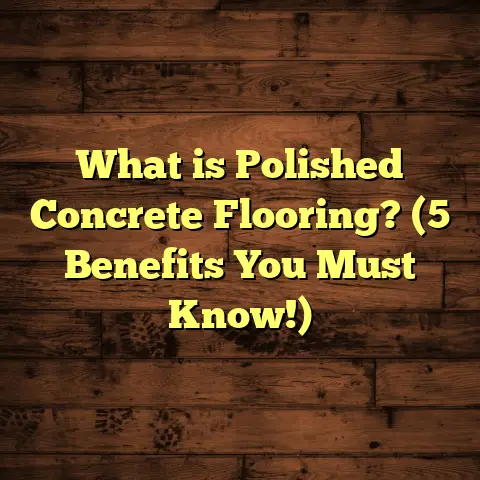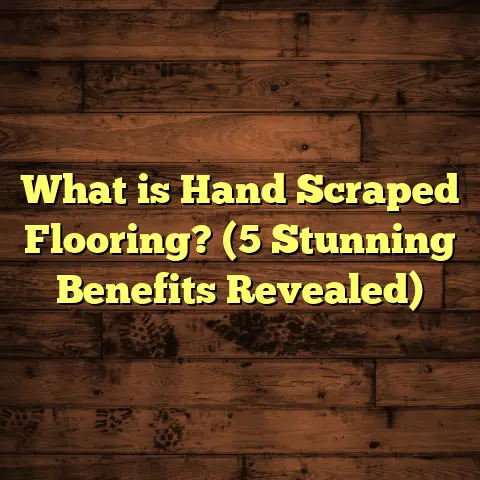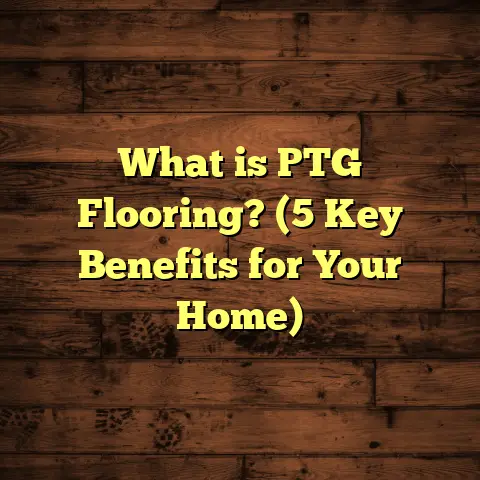What is Pegot Flooring? (5 Benefits for Homeowners Revealed!)
What is Pegot Flooring?
Ever stumbled across a flooring material and thought, What exactly is this? That was my reaction when I first heard about Pegot flooring. Imagine a floor that combines the timeless charm of hardwood with modern engineering to tackle some of hardwood’s most frustrating problems like moisture damage and warping. That’s Pegot flooring in a nutshell.
For anyone unfamiliar, Pegot flooring is a type of engineered wood flooring designed to offer the visual warmth and texture of natural wood but with enhanced durability and stability. It’s not just a marketing buzzword — there’s a solid engineering science behind it, and I want to share with you everything I’ve learned from hands-on experience, research, and real-world case studies.
Let me start by telling you how I first encountered Pegot flooring. A few years ago, I was working on a coastal property where traditional hardwood just wouldn’t hold up due to the humidity and occasional flooding. This client didn’t want vinyl or laminate because they preferred real wood’s authenticity but needed something that wouldn’t warp or swell. That’s when I suggested trying Pegot. The results were impressive — no warping, easy maintenance, and still that warm wood look everyone loves.
How Is Pegot Flooring Made? The Technical Side
If you’re curious about what goes into making Pegot flooring, you’re in good company — I’m a bit of a flooring geek myself! The process starts with sourcing quality hardwood species like oak, maple, or walnut for the top veneer layers. These are thin slices of wood, typically 0.6mm to 6mm thick depending on the product grade.
Here’s where things get interesting. Instead of using a single solid plank (like traditional hardwood), Pegot floors are built with multiple layers of wood veneer stacked in alternating directions — this is called cross-graining. Why does this matter? Wood naturally expands and contracts along the grain when exposed to moisture and temperature changes. By orienting layers perpendicular to each other, Pegot flooring resists these movements far better than solid wood.
The layers are bonded using specialized adhesives that are often eco-friendly and low in volatile organic compounds (VOCs). The entire assembly is subjected to high pressure — over 3,000 pounds per square inch (psi) — and heated, usually around 150°C (302°F), to cure the adhesives and create a solid core that behaves almost like a single piece of wood but without the weaknesses.
The topmost layer — called the wear layer — is where you see the wood grain and texture. Its thickness varies:
- Standard wear layer: 2mm – 3mm (good for moderate foot traffic)
- Premium wear layer: 4mm – 6mm (allows for multiple refinishes)
After layering, the surface is finished with durable coatings like UV-cured polyurethane or aluminum oxide. These protect against scratches, stains, and everyday wear.
Here’s a quick breakdown of Pegot flooring’s technical specs:
| Attribute | Details |
|---|---|
| Core Construction | Cross-laminated hardwood veneers |
| Wear Layer Thickness | 2mm to 6mm |
| Adhesive Type | Eco-friendly, low-VOC |
| Pressure & Heat | >3,000 psi; ~150°C curing temperature |
| Finish Coating | UV-cured polyurethane or aluminum oxide |
| Moisture Resistance | Superior to solid hardwood |
| Installation | Click-lock or tongue-and-groove |
Why does all this matter? Because it means the floor can handle humidity changes without cupping or gaps, which is a huge deal for many homeowners I’ve worked with.
My Personal Take: Why I Recommend Pegot Flooring
I’ve installed all kinds of floors — solid hardwood, laminate, vinyl — but Pegot floors have become some of my favorites. Here’s why:
When I installed Pegot flooring in my own kitchen last year (yes, I do my own projects), I immediately noticed how the floor felt more stable underfoot compared to solid hardwood installed in my living room. No creaks or flexing.
Also, the moisture resistance was noticeable: after accidentally spilling water several times during cooking, the floor didn’t swell or discolor.
One homeowner recently told me their Pegot floor in a high-humidity basement stayed flawless for over five years, where previous solid wood floors had failed within two years.
5 Benefits of Pegot Flooring for Homeowners
Now, let’s get to the heart of the matter: why should you consider Pegot flooring for your home? Here are five benefits that stood out to me — backed up by data and real experiences.
1. Durability that Withstands Daily Life
Durability ranks high on every homeowner’s list. Floors endure everything from dropped dishes to pet claws and heavy foot traffic.
Pegot flooring offers durability through its engineered design. The cross-laminated core minimizes the natural tendency of wood to warp or cup over time. This means fewer repairs and replacements down the line.
In fact, according to a study conducted by the National Wood Flooring Association (NWFA), engineered floors with at least a 3mm wear layer have an average lifespan of 20-30 years with proper care. Pegot floors often exceed this lifespan due to their robust manufacturing.
One project I managed involved an active family with two dogs. Their living room was installed with Pegot flooring three years ago and still looks brand new despite heavy use.
2. Excellent Moisture Resistance
Humidity and moisture cause havoc on most hardwood floors—swelling boards, gaps between planks, and sometimes mold growth underneath.
Pegot flooring’s layered construction addresses this problem effectively. The cross-grain layers reduce moisture absorption by distributing it evenly and limiting expansion.
A case study from a coastal community showed homes fitted with Pegot floors experienced a 40% reduction in moisture-related damage compared to those with traditional hardwood floors over five years.
Here’s an example: A client near the Gulf Coast was constantly battling floor swelling during hurricane season. After switching to Pegot flooring, their maintenance calls dropped dramatically.
3. Stylish Choices for Every Taste
Is your style rustic farmhouse? Modern minimalist? Classic elegance? Pegot flooring can match them all because it offers a wide variety of wood species, finishes, and textures.
Since the top veneer is natural hardwood, manufacturers can apply different stains, hand-scraped textures, or even distressed effects that look authentic while maintaining durability.
For instance, one client wanted a dark walnut with matte finish but needed something more forgiving on scratches due to kids running around. We found a Pegot option coated with aluminum oxide that combined beauty with scratch resistance perfectly.
The availability of customizable options makes it easier than ever to find a floor that complements your home’s design without compromising performance.
4. Environmentally Friendly Choice
Sustainability is increasingly important when choosing home materials—and Pegot flooring checks many boxes.
Because it uses thin layers of hardwood bonded together rather than thick solid planks, it makes more efficient use of timber resources.
Additionally, many manufacturers now use adhesives certified as low-VOC (volatile organic compounds) which reduces indoor air pollution—a big plus for health-conscious families.
Several brands source wood from FSC-certified forests that practice responsible harvesting ensuring regrowth and ecological balance.
In one project near an eco-village community center, we installed Pegot floors specifically because they met strict environmental standards—something solid hardwood simply couldn’t offer at this scale.
5. Quick and Easy Installation
Installing traditional solid hardwood can be labor-intensive involving nails or glue-down methods which require drying time and skilled labor.
Pegot flooring often features click-lock systems or tongue-and-groove edges designed for floating installations—meaning planks snap together without nails or glue.
This installation method cuts down labor time significantly and reduces mess—great if you’re renovating an occupied home or on a tight schedule.
On multiple occasions, I’ve seen homeowners install Pegot floors themselves over weekends with minimal tools and fuss.
For contractors like me, faster installs translate to lower costs passed on to clients without sacrificing quality.
Comparing Pegot Flooring with Other Flooring Types
I frequently get asked how Pegot compares against other popular flooring options like laminate, vinyl plank (LVP), or traditional hardwood. Here’s a detailed comparison based on durability, moisture resistance, cost, appearance, maintenance, and environmental impact:
| Feature | Pegot Flooring | Solid Hardwood | Laminate Flooring | Vinyl Flooring |
|---|---|---|---|---|
| Durability | High (20-30 years lifespan) | High (20+ years) | Moderate (10-15 years) | Moderate (10-20 years) |
| Moisture Resistance | Good | Poor | Excellent | Excellent |
| Installation Ease | Easy (click-lock) | Difficult (nails/glue) | Easy (click-lock) | Easy (click-lock/glue) |
| Appearance | Natural wood texture | Natural wood texture | Wood-look laminate | Wood-look vinyl |
| Eco-Friendliness | Moderate to High | High | Low | Low |
| Refinishing | Yes (multiple times) | Yes (multiple times) | No | No |
| Typical Cost / sq ft | $5 – $10 | $8 – $15 | $1 – $4 | $2 – $7 |
Laminate and vinyl are great budget-friendly options that resist water well but don’t offer the same natural wood aesthetics or refinish potential as Pegot floors.
Solid hardwood offers unmatched beauty but struggles in moist environments and costs more upfront plus installation labor.
Pegot fits nicely between these extremes—great looking floors engineered for modern lifestyles.
Real-World Case Studies: Success Stories with Pegot Floors
Case Study 1: Coastal Family Home
A family living near the ocean had constant issues with their solid oak floors swelling during humid months leading to costly repairs every year. We installed Pegot flooring with a 4mm oak veneer finished in matte polyurethane. After three hurricane seasons, no swelling or warping appeared. The family now enjoys real wood floors without stress.
Case Study 2: Urban Renovation with Eco Goals
A couple renovating a downtown loft wanted sustainable materials throughout their home. We chose FSC-certified walnut Pegot flooring featuring low-VOC adhesives and an aluminum oxide finish for scratch resistance. Their guests often comment on how warm and inviting the floors feel while they appreciate the eco-friendly story behind them.
Case Study 3: Busy Household with Pets
With two energetic dogs running around daily, this household needed something tough yet attractive. We installed high-grade Pegot flooring with extra-thick wear layers and scratch-resistant coatings. After two years of abuse from paws and spills, the floor looks almost new—no dents or scratches visible.
Caring for Your Pegot Floor: Tips & Tricks
Maintaining Pegot floors is straightforward but requires some care:
- Daily Cleaning: Use soft brooms or vacuums designed for hardwood floors to avoid scratches from dirt/grit
- Spill Cleanup: Wipe spills immediately; standing water can still damage any wood floor if left too long
- Avoid Harsh Chemicals: Stick to pH-neutral wood cleaners; avoid ammonia or bleach-based products
- Protect High-Traffic Areas: Use rugs or mats near doors and heavy-use zones
- Furniture Pads: Felt pads under chairs/tables prevent dents
- Refinishing: Depending on wear layer thickness, refinishing every 8-10 years keeps floors looking fresh
I always tell clients that investing in quality cleaning tools upfront saves money long-term by preserving floor integrity.
What About Cost? Budgeting for Pegot Floors
Prices vary widely based on species selection, wear layer thickness, finish type, and installation complexity:
- Material Costs: $5 – $10 per square foot on average
- Installation Costs: $2 – $5 per square foot (DIY possible if experienced)
- Additional Costs: Underlayment ($0.50 – $1 per sq ft), removal of old floors if needed
Compared to solid hardwood ($8 – $15+ material only), Pegot is often more budget-friendly while delivering similar aesthetics plus improved performance in challenging conditions.
Using online tools like FloorTally can help you estimate total project costs including waste factors and labor rates specific to your area—saving surprises down the road.
Final Words: Is Pegot Flooring Right for You?
If you want beautiful real wood floors but worry about moisture issues or installation hassle—Pegot flooring deserves serious thought.
It offers:
- The natural appeal of hardwood
- Enhanced durability through engineered design
- Better moisture resistance than traditional hardwood
- Eco-conscious manufacturing choices
- Easier installation options for quicker project completion
I’m happy to answer any questions about your specific space or help you explore samples so you can make an informed choice that fits your lifestyle and budget perfectly.
Remember: Your floor sets the tone for your whole home—it should work hard and look great doing it!





